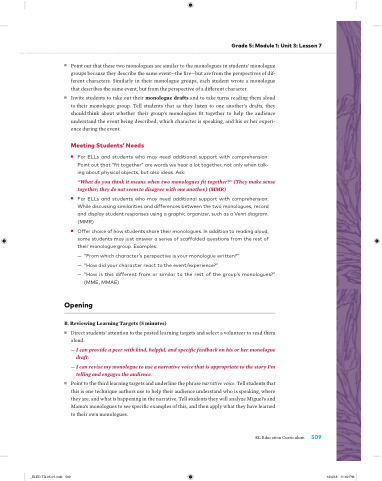Page 533 - EL Grade 5 Teacher Guide
P. 533
Grade 5: Module 1: Unit 3: Lesson 7
■ Point out that these two monologues are similar to the monologues in students’ monologue groups because they describe the same event—the re—but are from the perspectives of dif- ferent characters. Similarly in their monologue groups, each student wrote a monologue that describes the same event, but from the perspective of a di erent character.
■ Invite students to take out their monologue drafts and to take turns reading them aloud to their monologue group. Tell students that as they listen to one another’s drafts, they should think about whether their group’s monologues t together to help the audience understand the event being described, which character is speaking, and his or her experi- ence during the event.
Meeting Students’ Needs
■ For ELLs and udents who may need additional support with comprehension: Point out that “ t together” are words we hear a lot together, not only when talk- ing about physical objects, but also ideas. Ask:
“What do you think it means when two monologues t together?” (They make sense together; they do not seem to disagree with one another.) (MMR)
■ For ELLs and udents who may need additional support with comprehension: While discussing similarities and di erences between the two monologues, record and display udent responses using a graphic organizer, such as a Venn diagram. (MMR)
■ O er choice of how udents share their monologues. In addition to reading aloud, some udents may ju answer a series of sca olded que ions from the re of their monologue group. Examples:
— “From which character’s perspective is your monologue written?”
— “How did your character react to the event/experience?”
— “How is this di erent from or similar to the re of the group’s monologues?” (MME, MMAE)
Opening
B. Reviewing Learning Targets (5 minutes)
■
■
Direct students’ attention to the posted learning targets and select a volunteer to read them aloud:
— I can provide a peer with kind, helpful, and speci c feedback on his or her monologue draft.
— I can revise my monologue to use a narrative voice that is appropriate to the story I’m telling and engages the audience.
Point to the third learning targets and underline the phrase narrative voice. Tell students that this is one technique authors use to help their audience understand who is speaking, where they are, and what is happening in the narrative. Tell students they will analyze Miguel’s and Mama’s monologues to see speci c examples of this, and then apply what they have learned to their own monologues.
EL Education Curriculum 509
_ELED.TG.05.01.indb 509
12/4/18 11:49 PM


